CABEI: a leading development entity that fosters environmental sustainability in the region

CABEI establishes environmental sustainability as a cross-cutting strategic axis in all of its operations in order to continue to be a resilient and competitive entity.
San José, February 7, 2019.- The carbon footprint is composed of the amount of greenhouse emissions that are released into the atmosphere. It measures the impact of an activity on the planet. For the second consecutive year, the Central American Bank for Economic Integration (CABEI) in Costa Rica managed to maintain the certification of its building as Carbon Neutral.
This was achieved through a series of activities including awareness raising of personnel on issues related to environmental management, as well as on preventing and mitigating greenhouse gas emissions from the daily activities and operations of the institution on two lines of work: the measurement of the carbon footprint and the implementation of reduction actions in those sources that generate greenhouse gas emissions for subsequent compensation.
CABEI Country Manager for Costa Rica, Mauricio Chacón, noted that this achievement reflects a greater commitment to the region that is embodied in an environmental management system that integrates all business activity and includes all projects, services and products.
In recent years, the CABEI building in Costa Rica has contributed positively to the Bank's operational results with actions that have been implemented to reduce and offset greenhouse gases, adopting good environmental practices, energy efficiency, analysis of the technical specifications of products or services, as well as the efficient use of fuels in the Bank's vehicle fleet.
CABEI recognizes the importance of adequate management of environmental issues based on best international practices and standards, as a means to contribute to economic growth, poverty reduction and environmental sustainability in the region.







